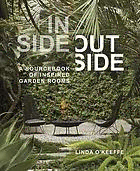
Inside outside : a sourcebook of inspired garden rooms PDF
Preview Inside outside : a sourcebook of inspired garden rooms
INSIDE OUTSIDE A SOURCEBOOK of INSPIRED GARDEN ROOMS LINDA O’KEEFFE Timber Press Portland, Oregon FRONTISPIECE On the exterior kitchen wall of Carl D’Aquino and Bernd Goeckler’s Hudson Valley house, ceramic wall plaques created by Alexandre Bigot in the 1930s echo the style of the interior’s furnishings and help obliterate the distinction between the garden and the front porch. OPPOSITE In Robert Couturier’s Connecticut garden, a bronze table and chairs create an impromptu room at the base of stairs surrounded by shapely bushes. Copyright © 2019 by Linda O’Keeffe. All rights reserved. Photography credits appear on page 245. Published in 2019 by Timber Press, Inc. The Haseltine Building 133 S.W. Second Avenue, Suite 450 Portland, Oregon 97204-3527 timberpress.com Printed in China Jacket design by Claudia Brandenburg/Language Arts ISBN 978-1-60469-826-8 Catalog records for this book are available from the Library of Congress and the British Library. To Sal. CONTENTS 9 13 51 INTRODUCTION SPACE STRUCTURE Line Drawing 17 Hedging Bets 55 Greenhouse Affect 27 Outside the Box 67 Soulful Soil 33 Shear Genius 73 Poetry in Motion 43 Court in the Act 83 91 129 163 MOVEMENT MOOD FURNITURE As the Crow Flies 95 Blush Strokes 133 Musical Chairs 167 A Path of Least Resistance 105 House of Blues 141 All Hands on Deck 175 Heaven Scent 111 Awesome Ore 149 Surreal Estate 183 The Plot Thickens 121 Depth of Field 155 Greenery Scenery 189 197 242 TIME FURTHER READING Karmic Calm 201 244 Sun Worship 211 ACKNOWLEDGMENTS Romancing the Stone 219 Grand Allusion 225 245 Home Sweet Home 235 PHOTOGRAPHY CREDITS 247 INDEX INTRODUCTION 9 in a quest to satisfy their clients’ nesting instincts, interior and landscape designers share an aesthetic lexicon. As space planners, they both rely OPPOSITE Two fences covered on structure and think of soft and hard materials, color, texture, lighting, and with star jasmine or Japanese accessories as everyday tools. They consider circulation, visual pacing, proces- silverberry converge in Scott Flax’s Santa Monica garden. sion, and flow. They configure and decorate walls and install furniture. They They provide a backdrop for edit, edit, edit or weed, weed, weed. The basic thought processes behind the a set of teak chairs in a sitting area where Flax covered design of a hall, a corridor, a pathway, and an allée are interchangeable—doors a side table with antique and gates serve the same purpose, and there’s little difference between laying a Portuguese tiles and placed a bowl created by Philip stone floor in a kitchen or in a courtyard. Maberry and Scott Walker. It is quaint to think of a garden as a house’s appendage rather than its continuation, and this book treats the two as sides of the same coin. In some Thanks to a glass wall, a cube chair in the living room of a cases, a house flows seamlessly into its surroundings, but even when indoor California house designed by and outdoor spaces aren’t literal extensions of each other, they can share a Charles Allum appears to be a three-dimensional continua- sensibility. Interior designers often look to nature when they choose color tion of a white terrazzo and schemes, and for some, including Barbara Barry, whose interiors often wear grass checkerboard floor in an adjacent courtyard. the “colors of the earth dressed up to live inside,” that symbiosis has devel- oped into a signature style. Since time immemorial, interior and landscape designers have inspired one another. When celebrated author and garden designer Luciano Giubbilei first ventured into horticulture in the mid-1990s, his gardens were heavily influenced by interior décor. He was particularly enamored with the work of Christian Liaigre, of whom he recalled, “There was a movement, a dynamic in the way he arranged a room . . . with one piece that would break the symmetry and the stiffness within his compositions.” All gardens represent a valiant attempt to tame our immediate environ- ment, both to embrace nature and keep her at bay. A logical way to organize any space—be it a meadow or a gymnasium-size loft—is to break it down into manageable portions, or rooms. This technique is as old as the hills. It’s identifiable in Persian quadrant layouts, in ancient Egyptian courtyards, and in Baroque parterres. In this book, I define a “room” in loose terms. The word
